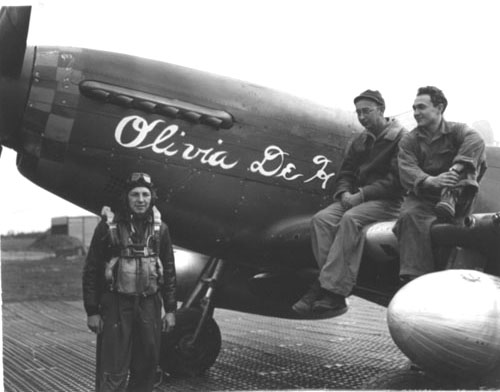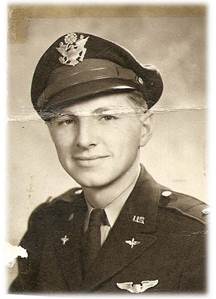
1st Lt. Raymond T. “Ted” Conlin, with his Olivia De H, 44-13316, C5-C, which he got from Maj. Kit Carson.
Two great stories from Ted:
D Day A Year Before The Big Bang
There was electricity in the air as we went about the business of running the war on June 5th, 1944. Our base at Leiston, England, had been shut down earlier in the morning, that day. No one was permitted to enter or leave the field from 0800 hrs. on. The rumor was that the invasion was imminent and all England was alive with activity.
At 2000 hours, everyone was assembled in the hall to hear an address from General Eisenhower, who informed us that, indeed the was only hours away, that 0600 the next morning was designated as “H” hour, the actual time that the troops were to hit the beaches. The General told us that this would be the most important mission that anyone of us would ever take part in, and that our job was to protect those brave guys that were to execute the landings. Our primary aim was not to permit any air action by the enemy that would endanger those men of ours making the operation.
Following the general, we were briefed by Col. Don Graham, our base commander as to the specific areas each of the squadrons were to be assigned to patrol and we were given the takeoff times for each squadron. I was in the 362nd and our takeoff was given as 0500 hrs and our patrol area was at 27,000 ft. over the Jersey & Guernsey Islands, which were just off the west end of the Normandy coast.
Following this, our squadron leader, Capt. Joe Broadhead, assigned the flight leaders, element leaders and all the various wingmen. I was assigned to fly Capt. Broadhead’s wing.
I don’t think anyone of us got a decent sleep the rest of that night until we were awakened by the C.Q. and reported to the flight line operations room for a tasteless breakfast and flight prep prior to takeoff.
Promptly at 0500 hrs., the Captain and I roared down the runway and ran smack into a low heavy overcast, which was almost down to the deck. We went on the gages at once. This was weather with a Capitol W. After about 40 minutes, we broke into the clear and arrived on station and on time. It was now very close to “H” hour.
When we were getting ready to go, I had to go but decided I would wait until we arrived at the designated area. At that time I would avail myself of the relief tube that North American had so thoughtfully provided for such an emergency. As we settled into a patrol formation, I started to undo all the straps, belts and zipper to accomplish my objective. It was at that exact moment that the Captain called to inform me that he and I were going to go down to take a look at the invasion. Egad! That meant 5 miles down on the gauges and then 5 miles back up. Well, orders is orders so down we went. Just as we broke out of the overcast at 2000 ft. near the west end of Omaha Beach, we heard on the RT that two enemy 109s had made one pass strafing from west to east. We just missed engaging them by a few seconds. After several minutes of stooging around, we headed back up to join the rest of the boys.
Of course, with all the excitement and the trip down to the invasion beaches, I forgot all about my personal problem which wasn’t resolved until return to base some 3 hours later.
1st Lt. Raymond T. Conlin

“I saw nothing except nine burning wrecks over an area of several square miles.”
It was late in the afternoon of a very weird day, weather wise. The 357th Fighter Group was on the prowl and my squadron, the 362nd was split into two halves with Captain Lowell Williams leading one flight. I was his element lead and had Jim Blanchard as my wing man. Williams took us north toward the Zuider Zee, the huge inland waterway in northern Holland. The weather to the east was clear and bright. To the west, a large front had rolled in off the North Sea. It had many angry multi-colored storm clouds and cast a gray pallor on the afternoon.
As we neared the Zee, we began to pick up considerable radio traffic, indicating a fight was beginning somewhere to the south of us. Williams ordered a course change to due south.
When we altered our direction, the radio activity picked up almost at once. It was apparent to us that elements of our Group had gotten into action. We could hear guys cussing and shouting as they engaged the enemy. Most pilots, in the excitement of battle, would inadvertently hold down the mike buttons., This gave us a good picture of what was happening.
Williams gave the order to “drop tanks.” Just as he did, the fit hit the shan. It was standard operating procedure in a fight, to break down to the smallest unit. Williams and his wingman banked over and onto a Me 109. At that moment, three aircraft crossed my nose, a Me 109, a P-51 and another 109 all headed straight down. I rolled over and down to the attack, chasing the “tail end charley” 109. My closure was rapid and my new high tech gun sight was on. Just as I drew into firing range, I saw a cluster of 20mm shells arcing over my left wing. I broke off at once to handle my problem, climbing straight up to 10,000 feet. I knew I was able to gain altitude on my adversary. At this height, I went into a tight turn but saw nothing. I called for my wingman, Blanchard and for the leader, Williams but received no reply. Now I was mad and scared and wanted to shoot something. So, I nosed over and dove down to the battle area. At 2,000 feet, I leveled off and circled. I saw nothing, zero, zilch. Nothing, except nine burning wrecks over an area of several square miles.
It amazes me that the sky can be filled with airplanes one minute and be totally empty in the next. After milling around for several more minutes I turned west, climbed up to altitude, and headed on a course for home base.
While attending a reunion of the 357th Fighter Group, at Dayton, Ohio, in 1987, I was discussing this battle with Col. Robie Roberson, pilot and M/Sgt Merle Olmstead, crew chief and active historian of our group. At that time, I told them I was almost dead certain that the P-51 in the middle of the chase was the Group leader that day, Maj. Ed Hiro. He was on his last mission. Both Hiro, and my wingman, Blanchard, failed to return and both were later classified as KIA.
A combat report filed by a Lt. Wroblewski of the Luftwaffe for that day claiming the destruction of the P-51 of Lt Blanchard. This report was filed after the war with the newly created German Air Force. The German officer stated that he was, at once shot down himself, and became a prisoner of the Canadians of the next two years, being released in 1946.
Among the ironies of war, Wroblewski later became Air Attaché in Washington and, it is believed that the became Chief of Staff, GAF and retired as a General Officer.
The aircraft of Lt. Blanchard was recovered in 1946, imbedded in a canal. Jim was found, strapped in to his plane and positive ID was made.
Operation Market Garden was not a 100% success for the Allies. My personal opinion is that too many people knew when it was to happen, where to happen and who the players were to be. The enemy were well prepared and waiting for us. They hit the British hard at Arnhem and our 82nd and 101st Airborne found them waiting at Nimijen Bridgehead.
Our 357th Fighter Group played an important role in the battles which took place over four days, for us. And we paid the price losing key men and aircraft. Thus is extracted the price of war.
Ted Conlin
THE YOXFORD BOYS AND THE ARNHEM AFFAIR: THE 357TH FG IN OPERATION MARKET GARDEN
“…the other side – Aircombat over Arnhem between II./JG11 and 357th FG on Sept 19th, 1944”

